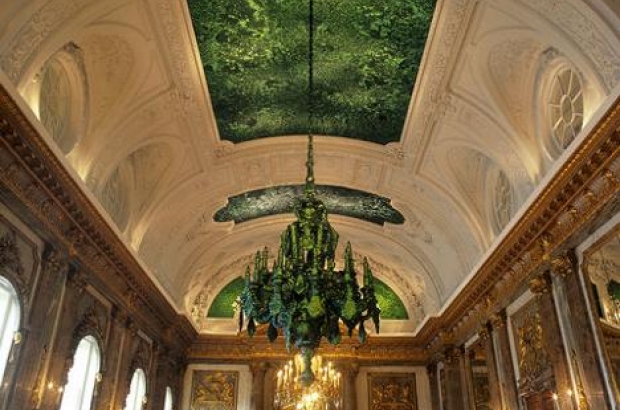- Daily & Weekly newsletters
- Buy & download The Bulletin
- Comment on our articles
5 must-see pieces of art in Belgium
Europe is filled with impressive art from across empires and centuries. But tiny Belgium holds its fair share of the continent’s cultural riches. Here are five essential pieces of Belgian art that any visitor or resident should see at least once in their lifetimes.
1. The Ghent Altarpiece, Hubrecht and Jan van Eyck
While its portraits and depictions of saints and angels, martyrs, prophets and lambs may have lost their cultural touchstones for many, no list of great Belgian art is complete without the still-powerful Ghent Altarpiece.
Begun by older brother Hubrecht and finished by Jan Van Eyck, this 12-panelled polyptych was one of the earliest painted altarpieces in Europe. Also called the Adoration of the Mystic Lamb or The Lamb of God, it is considered the height of Nederlandish art.
To fully understand the work, it’s worth paying for one of the multilingual audio guides for a panel-by-panel explanation of this complex and unique masterpiece.
Right now, viewing the whole altarpiece, which usually resides in Saint Bavo’s Cathedral in Ghent, requires a bit of legwork. A third of the panels are currently at the Ghent Museum of Fine Arts (MSK) undergoing restoration, part of a seven-year restoration project due to be finished in 2019. At the MSK, restorers are at work behind a glass wall where visitors can come and watch their progress.
Throughout the restoration, the parts of the artwork not currently being restored will remain on display at Saint Bavo’s , the masterpiece’s home since it was created in 1432.
For true art history buffs, the Caermersklooster centre for culture and the arts has a permanent exhibition on the painting techniques and symbolism found in the Altarpiece. There is also a temporary exhibition following the stages of the restoration process.
Of course, then there’s the stolen panel. Earlier this year, a missing panel depicting the Righteous Judges, stolen in 1934, was tracked down 80 years after its theft. In March, historian and member of the Brussels Parliament Paul De Ridder claimed to have traced the panel to the home of a prominent Ghent family, though it has yet to be recovered.
2. Madonna of Bruges, Michelangelo
This tender marble sculpture of Madonna and child, which has sat in the Church of Our Lady in Bruges since 1514, was the only sculpture by Michelangelo that left Italy in the maestro’s lifetime.
This touching, elegant piece shows not an adoring mother coddling her child, but a toddler Jesus taking his first steps away from his mother while Mary looks down and away with a sad, knowing glance. The pathos in Mary’s face has led many to speculate that she is already aware of her son’s fate. For this reason, the work has often been considered alongside the artist’s Pietà, created around the same time and found in Saint Peter’s Basilica in the Vatican, where the Virgin mourns over her son’s body draped across her lap.
3. Dulle Griet, Pieter Bruegel the Elder
One of Bruegel’s most famous paintings, and among his most mysterious, Dulle Griet (1562) is the artist’s only painting hanging in Flanders.
Found in the Museum Mayer van den Bergh in Antwerp, Dulle Griet (often translated as Mad Meg in English and used to mean a hellcat or a shrewish woman in Dutch) is a wild-looking woman storming through a bizarre scene of mayhem and chaos. She dons a suit of armour and carries a sword in one hand and cutlery and a money chest in another.
While Bruegel’s intention is not entirely clearly, many believe that Dulle Griet is Bruegel condemning unmannered, aggressive women. His Griet is leading a raging army of angry women straight into the mouth of Hell, leaving a fiery holocaust in their wake.
4. Son of Man, René Magritte
Since 1964, an apple and a bowler hat have been the symbols of surrealist art. For many the iconic image of René Magritte’s Son of Man, which can be found in the Magritte Museum in Brussels, represents not only an art movement that stemmed from Belgium, but the country itself with all its quirks and unexpected inconsistencies.
The painting is a self-portrait of Magritte decked out in an overcoat and bowler hat, standing at the seaside below stormy skies with a large green apple hovering just in front of his face.
Magritte explained his reason for obscuring the face as: “Everything we see hides another thing; we always want to see what is hidden by what we see. There is an interest in that which is hidden and which the visible does not show us. This interest can take the form of a quite intense feeling, a sort of conflict, one might say, between the visible that is hidden and the visible that is present.”
5. Heaven of Delight, Jan Fabre
While animal rights activists might not like it, it's hard not to be impressed when peering up at Jan Fabre’s Heaven of Delight. This ethereal ceiling in the Royal Palace of Brussels strikes most as a painting, but is is in fact made out of the wing cases of 1.6 million jewel scarabs: sometimes green, sometimes blue, depending on how the light hits them. In 2009, Fabre enlisted the help of 29 young artists to blanket the ceiling and chandelier of the palace’s Hall of Mirrors with these iridescent insects that are commonly eaten as snacks in Thailand. The result is impressive.
This is not Fabre’s only artwork that targets the bug world. On Leuven’s Ladeuzeplein, a 20-metre needle stands erect with a giant beetle stuck on through its pointed end – a sculpture also by Fabre.



















Comments
I've seen both the Son of Man and Heaven of Delight. My husband and I are planning a trip this summer to see Madonna. We can't wait. Belgium is so beautiful.
Debbie
receptionist @ Tree Pruning Columbia